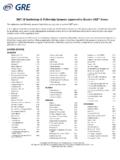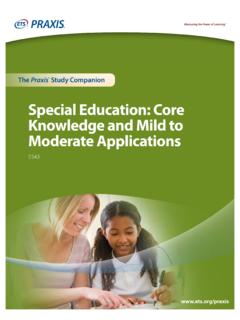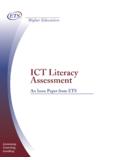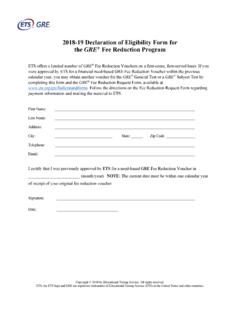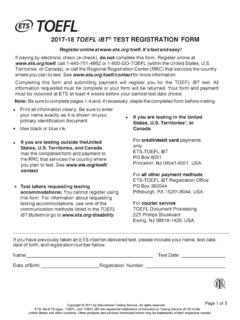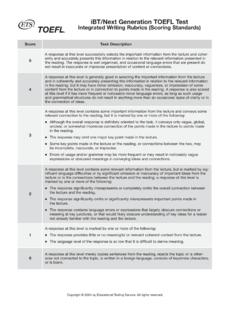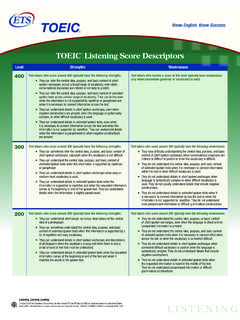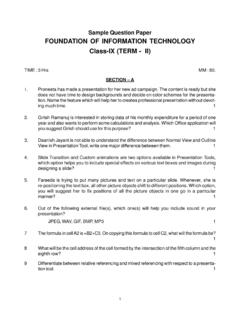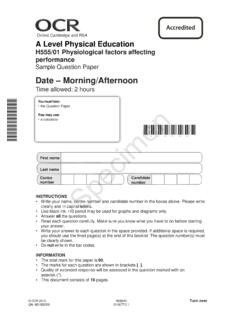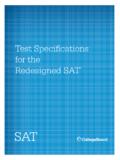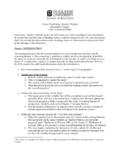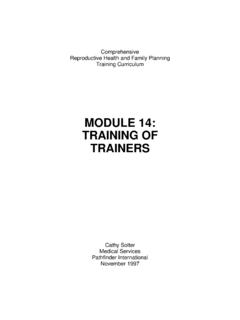Transcription of Art: Content and Analysis - Educational Testing …
1 Art: Content and Analysis Praxis Study CompanionThe Praxis Study Companion2 Welcome to the Praxis Study CompanionWelcome to The Praxis Study Companion Prepare to Show What You KnowYou have been working to acquire the knowledge and skills you need for your teaching career. Now you are ready to demonstrate your abilities by taking a Praxis test. Using the Praxis Study Companion is a smart way to prepare for the test so you can do your best on test day. This guide can help keep you on track and make the most efficient use of your study Study Companion contains practical information and helpful tools, including: An overview of the Praxis tests Specific information on the Praxis test you are taking A template study plan Study topics Practice questions and explanations of correct answers Test-taking tips and strategies Frequently asked questions Links to more detailed informationSo where should you start?
2 Begin by reviewing this guide in its entirety and note those sections that you need to revisit. Then you can create your own personalized study plan and schedule based on your individual needs and how much time you have before test in mind that study habits are individual. There are many different ways to successfully prepare for your test. Some people study better on their own, while others prefer a group dynamic. You may have more energy early in the day, but another test taker may concentrate better in the evening. So use this guide to develop the approach that works best for teaching career begins with preparation. Good luck!Know What to ExpectWhich tests should I take? Each state or agency that uses the Praxis tests sets its own requirements for which test or tests you must take for the teaching area you wish to you register for a test, confirm your state or agency s Testing requirements at are the Praxis tests given?
3 Praxis tests are given on computer. Other formats are available for test takers approved for accommodations (see page 44).The Praxis Study Companion3 Welcome to the Praxis Study CompanionWhat should I expect when taking the test on computer?When taking the test on computer, you can expect to be asked to provide proper identification at the test center. Once admitted, you will be given the opportunity to learn how the computer interface works (how to answer questions, how to skip questions, how to go back to questions you skipped, etc.) before the Testing time begins. Watch the What to Expect on Test Day video to see what the experience is and when are the Praxis tests offered?You can select the test center that is most convenient for you. The Praxis tests are administered through an international network of test centers, which includes Prometric Testing Centers, some universities, and other locations throughout the schedules may differ, so see the Praxis web site for more detailed test registration information at The Praxis Study Companion4 Table of ContentsTable of ContentsThe Praxis Study Companion guides you through the steps to success1.
4 Learn About Your Test ..5 Learn about the specific test you will be taking2. Familiarize Yourself with Test Questions ..10 Become comfortable with the types of questions you ll find on the Praxis tests3. Practice with Sample Test Questions ..14 Answer practice questions and find explanations for correct answers4. Determine Your Strategy for Success ..28 Set clear goals and deadlines so your test preparation is focused and efficient5. Develop Your Study Plan ..31 Develop a personalized study plan and schedule6. Review Study Topics ..35 Detailed study topics with questions for discussion7. Review Smart Tips for Success ..42 Follow test-taking tips developed by experts8. Check on Testing Accommodations ..44 See if you qualify for accommodations that may make it easier to take the Praxis test9. Do Your Best on Test Day ..45 Get ready for test day so you will be calm and confident10.
5 Understand Your Scores ..47 Understand how tests are scored and how to interpret your test scoresAppendix: Other Questions You May Have ..49 The Praxis Study Companion5 Step 1: Learn About Your Test1. Learn About Your TestLearn about the specific test you will be takingArt: Content and Analysis (5135)Test at a GlanceTest Name Art: Content and AnalysisTest Code 5135 Time 2 hoursNumber of Questions 85 selected-response questions ( part A); 3 constructed-response questions ( part B) Format Selected-response and constructed-response questionsWeighting Selected-response questions: 75 percent of total score; Constructed-response questions: 25 percent of total scoreTest Delivery Computer delivered Approximate Approximate Content Categories Number of Percentage of Questions Examination part A: Selected-response questions 85 75% I.
6 Art Making 55 48% A. General 11 B. Media and Processes 44 II. Historical and Theoretical Foundations of Art 30 27% A. Materials and Processes in an Art 5 Historical Context B. The Western Tradition in Art History 12 C. Art Beyond the Western Tradition 6 D. Responding to Art 7 part B: Constructed-response questions 3 25% III. Art Analysis 3 25% A. Historical and Theoretical Foundations of Art 1 B. Art Making 2 IIIIIIA bout This TestArt: Content and Analysis measures whether entry-level art teachers have the standards-relevant knowledge, skills, and abilities deemed necessary for beginning professional practice. The test is intended primarily for individuals completing teacher training programs who plan to become art teachers. Test takers typically have completed a bachelor s degree program in art or art education.
7 The test questions focus on concepts that are considered central to the study of art, measuring knowledge of art making and the historical and theoretical foundations of Praxis Study Companion6 Step 1: Learn About Your TestIn part A, images are included with some of the selected-response questions. In part B, the three constructed-response questions are divided between one 15-minute question Testing historical and theoretical foundations of art and two 10-minute questions Testing art historical and theoretical foundations of art, test takers are asked to respond to a general topic by selecting, identifying, and analyzing a relevant art historical example from memory. Test takers may select a work of art from any culture and any art historical period, but the work must be verifiable. It must appear either in a textbook or online. It may not be your own work or an example of student work.
8 In analyzing the selected work, test takers will have to supply specific visual evidence from memory, as well as engage with relevant art historical and theoretical art making, test takers are asked to write about two (2) works of art that they have created in two different media. Before the test date, test takers will select four (4) works they feel comfortable writing about, photograph or scan each work to a digital JPG file (3 MB or smaller), upload the four (4) digital images online via My Praxis Account, and print a copy of each image (one image per page). During the uploading process, test takers will enter general information such as title, date of completion, media, and dimensions. Each image is given a system-generated ID number that will appear on each image printout. The deadline to upload these images is no later than 3 days before test day.
9 For example, the deadline to upload images for a Saturday appointment is Wednesday at 11:59 ET. Test takers may change their images and edit the artwork information at any time before this of the two art-making questions requires test takers to choose one of the four works to write about. The two digital image files that are chosen and used for the art-making responses will be associated with the relevant questions through the system-generated ID number. Therefore, it is extremely important for test takers to bring the printouts of all four digital reproductions of their work to the Testing site. The ID number appearing on the printouts is a critical part of the art-making responses. Test takers will be asked to enter this image ID number as the first line of their response on test day. If the ID number is not entered correctly, THE ART-MAKING RESPONSE WILL NOT BE SCORED.
10 The system-generated ID number must be entered as the first line of each art-making response and must have the EXACT format shown on the prints of your image files. Do NOT embed the ID in the text of your response, and do not write anything else on the first line other than the ID addition, if a test taker responds to both art making questions with work in the same medium, the response for the second art making essay will not be SpecificationsTest specifications in this chapter describe the knowledge and skills measured by the test. Study topics to help you prepare to answer test questions can be found on page Art MakingA. GeneralThe test taker:1. Knows and understands how to create and critique personal artwork using at least two art processes and mediaa. brings in reproductions that exhibit two different processes and that are certified as the test taker s own workb.
